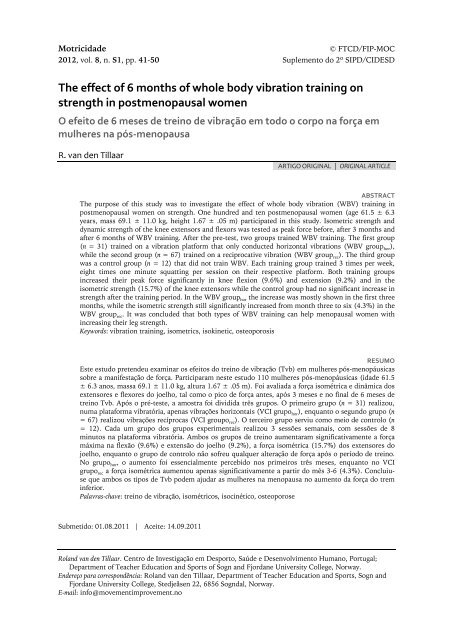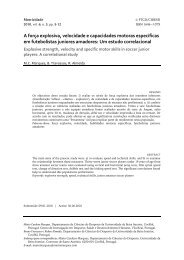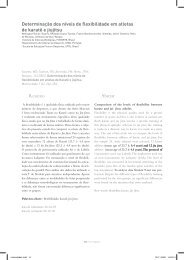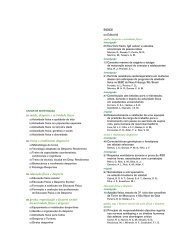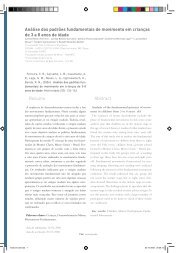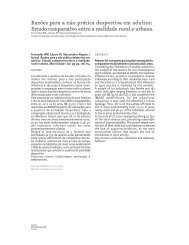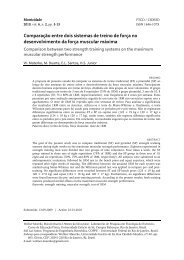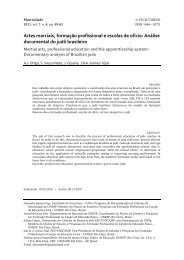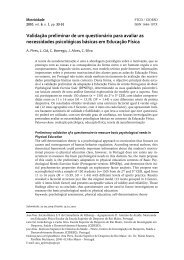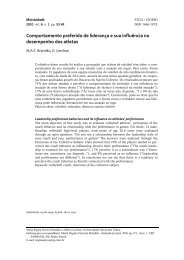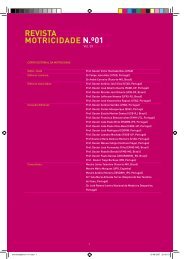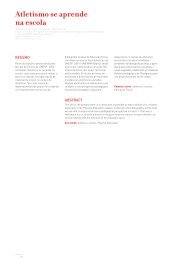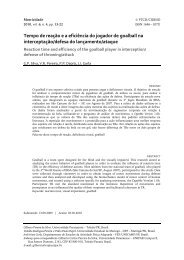revista motricidade
revista motricidade
revista motricidade
- No tags were found...
Create successful ePaper yourself
Turn your PDF publications into a flip-book with our unique Google optimized e-Paper software.
Motricidade<br />
© FTCD/FIP-MOC<br />
2012, vol. 8, n. S1, pp. 41-50 Suplemento do 2º SIPD/CIDESD<br />
The effect of 6 months of whole body vibration training on<br />
strength in postmenopausal women<br />
O efeito de 6 meses de treino de vibração em todo o corpo na força em<br />
mulheres na pós-menopausa<br />
R. van den Tillaar<br />
ARTIGO ORIGINAL | ORIGINAL ARTICLE<br />
ABSTRACT<br />
The purpose of this study was to investigate the effect of whole body vibration (WBV) training in<br />
postmenopausal women on strength. One hundred and ten postmenopausal women (age 61.5 ± 6.3<br />
years, mass 69.1 ± 11.0 kg, height 1.67 ± .05 m) participated in this study. Isometric strength and<br />
dynamic strength of the knee extensors and flexors was tested as peak force before, after 3 months and<br />
after 6 months of WBV training. After the pre-test, two groups trained WBV training. The first group<br />
(n = 31) trained on a vibration platform that only conducted horizontal vibrations (WBV group hor ),<br />
while the second group (n = 67) trained on a reciprocative vibration (WBV group rec ). The third group<br />
was a control group (n = 12) that did not train WBV. Each training group trained 3 times per week,<br />
eight times one minute squatting per session on their respective platform. Both training groups<br />
increased their peak force significantly in knee flexion (9.6%) and extension (9.2%) and in the<br />
isometric strength (15.7%) of the knee extensors while the control group had no significant increase in<br />
strength after the training period. In the WBV group hor the increase was mostly shown in the first three<br />
months, while the isometric strength still significantly increased from month three to six (4.3%) in the<br />
WBV group rec . It was concluded that both types of WBV training can help menopausal women with<br />
increasing their leg strength.<br />
Keywords: vibration training, isometrics, isokinetic, osteoporosis<br />
RESUMO<br />
Este estudo pretendeu examinar os efeitos do treino de vibração (Tvb) em mulheres pós-menopáusicas<br />
sobre a manifestação de força. Participaram neste estudo 110 mulheres pós-menopáusicas (idade 61.5<br />
± 6.3 anos, massa 69.1 ± 11.0 kg, altura 1.67 ± .05 m). Foi avaliada a força isométrica e dinâmica dos<br />
extensores e flexores do joelho, tal como o pico de força antes, após 3 meses e no final de 6 meses de<br />
treino Tvb. Após o pré-teste, a amostra foi dividida três grupos. O primeiro grupo (n = 31) realizou,<br />
numa plataforma vibratória, apenas vibrações horizontais (VCI grupo hor ), enquanto o segundo grupo (n<br />
= 67) realizou vibrações recíprocas (VCI groupo rec ). O terceiro grupo serviu como meio de controlo (n<br />
= 12). Cada um grupo dos grupos experimentais realizou 3 sessões semanais, com sessões de 8<br />
minutos na plataforma vibratória. Ambos os grupos de treino aumentaram significativamente a força<br />
máxima na flexão (9.6%) e extensão do joelho (9.2%), a força isométrica (15.7%) dos extensores do<br />
joelho, enquanto o grupo de controlo não sofreu qualquer alteração de força após o período de treino.<br />
No grupo hor , o aumento foi essencialmente percebido nos primeiros três meses, enquanto no VCI<br />
grupo rec a força isométrica aumentou apenas significativamente a partir do mês 3-6 (4.3%). Concluiuse<br />
que ambos os tipos de Tvb podem ajudar as mulheres na menopausa no aumento da força do trem<br />
inferior.<br />
Palavras-chave: treino de vibração, isométricos, isocinético, osteoporose<br />
Submetido: 01.08.2011 | Aceite: 14.09.2011<br />
Roland van den Tillaar. Centro de Investigação em Desporto, Saúde e Desenvolvimento Humano, Portugal;<br />
Department of Teacher Education and Sports of Sogn and Fjordane University College, Norway.<br />
Endereço para correspondência: Roland van den Tillaar, Department of Teacher Education and Sports, Sogn and<br />
Fjordane University College, Stedjeåsen 22, 6856 Sogndal, Norway.<br />
E-mail: info@movementimprovement.no


